Set out on a captivating journey through the heart of Phnom Penh, Cambodia, with the ‘Visit 11 Places in the City Included S21 & Killing Field’ tour.
This immersive experience is like peeling back the layers of a complex tapestry, revealing the city’s vibrant present and haunting past.
In just 8 hours, you will uncover the secrets of iconic sites such as the Royal Palace, the National Museum, and the Cambodian Vietnam Friendship Monument.
But the tour goes beyond the surface, delving into the depths of history with visits to the Genocide Museum and the Killing Fields.
Led by a knowledgeable local guide, this tour promises to be a thought-provoking exploration, offering profound insights into Phnom Penh’s distant and recent past.
Don’t miss this chance to discover the hidden gems of this remarkable city.
Good To Know
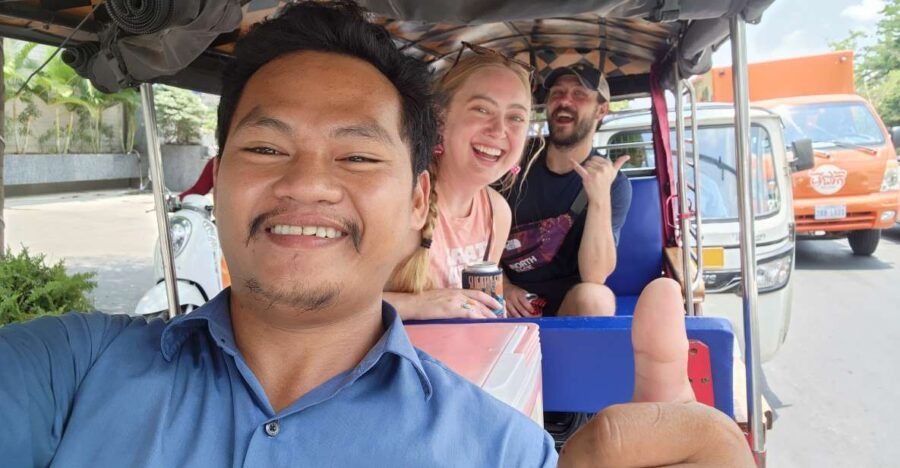
- The activity offers free cancellation up to 24 hours in advance for a full refund.
- Pickup is included in the activity and the guide will meet you in the lobby of your accommodation.
- The tour includes visits to significant sites in the city, such as Wat Phnom, The National Museum, The Royal Palace, and The Killing Fields.
- Cash is recommended for entrance fees and food, as credit cards may not be accepted.
Wat Phnom and Lady Penh Statue
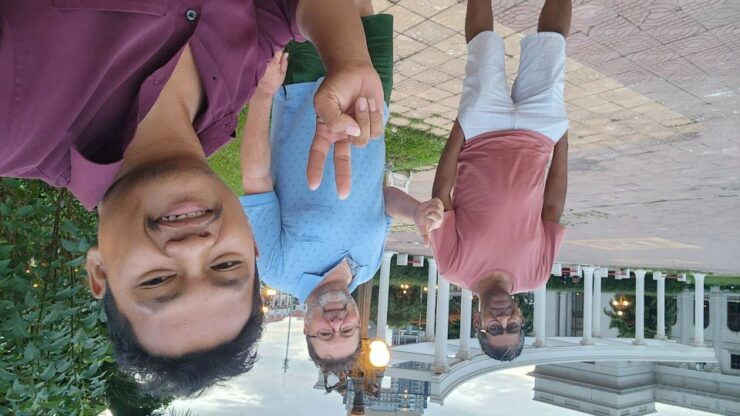
The first stop on the tour is Wat Phnom and the Lady Penh Statue, where visitors can learn the fascinating story of Lady Penh. Lady Penh, also known as Daun Penh, was a wealthy widow who discovered four bronze statues of Buddha floating on the Mekong River. Inspired by this sacred find, she decided to build a small hill, known as Wat Phnom, and enshrined the statues there, establishing the first pagoda in Phnom Penh. Lady Penh’s story and significance are deeply rooted in Cambodian history and culture.
Wat Phnom itself isn’t only a significant religious site, but it also boasts impressive historical and architectural features. The temple, built in 1372, stands on a 27-meter-tall hill and offers panoramic views of the city. Its striking design showcases the blend of Khmer and Buddhist influences, with intricate carvings and colorful murals adorning its walls. The peaceful atmosphere and lush gardens surrounding Wat Phnom make it a serene retreat in the bustling city.
Want to see more of Phnom Penh? Other city tours we've reviewed
Wat Onnalom
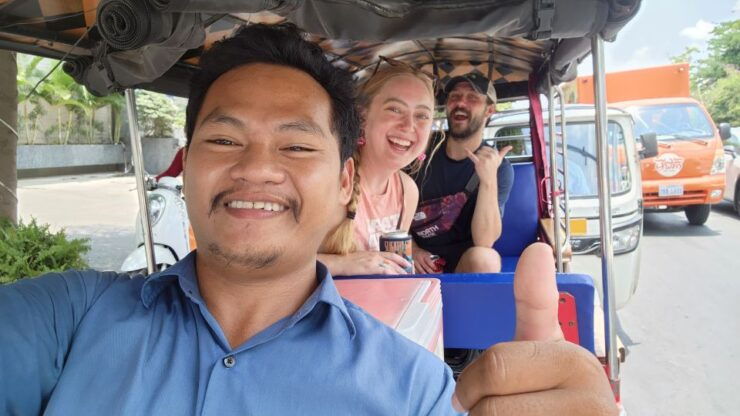
Continuing the exploration of significant sites in Phnom Penh, the next stop after Wat Phnom and the Lady Penh Statue is Wat Onnalom, one of the most important monasteries in the city. This monastery, located in Sangkat Wat Phnom, offers visitors a chance to explore Buddhist architecture while learning about Cambodian history.
Here is a table highlighting some key information about Wat Onnalom:
| Location | Hours of Operation | Entrance Fee |
|---|---|---|
| Sangkat Wat Phnom | 8:00 AM – 5:00 PM | Free |
As one of the oldest monasteries in Phnom Penh, Wat Onnalom holds great cultural and religious significance. It is known for its stunning traditional Khmer-style architecture, with intricate carvings and beautiful pagodas. Visitors can admire the serene atmosphere and explore the various buildings within the monastery complex.
Inside the monastery, there is a library that houses a collection of ancient Buddhist scriptures, providing insight into Cambodia’s religious heritage. Plus, Wat Onnalom serves as a place of worship and meditation for monks and devotees, offering a glimpse into the daily life of Buddhist practitioners.
A visit to Wat Onnalom is a must for those interested in exploring the rich Buddhist heritage of Cambodia and delving deeper into its fascinating history.
The National Museum
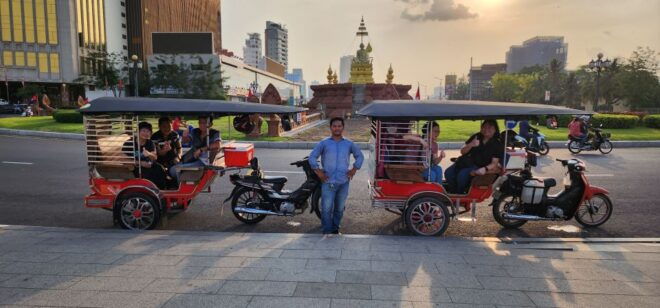
Located in Phnom Penh, the National Museum showcases traditional Cambodian architecture and offers a fascinating glimpse into the country’s rich cultural heritage.
The significance of traditional Cambodian architecture in the National Museum can’t be overstated. The museum’s stunning buildings, inspired by Khmer temple architecture, provide a majestic backdrop for the displays of ancient artifacts and artwork.
Visitors can explore the galleries filled with exquisite sculptures, ceramics, and textiles that highlight Cambodia’s artistic achievements throughout its history.
Plus, the museum provides an opportunity to explore the cultural impact of the Cambodian Vietnam Friendship Monument. This monument symbolizes the enduring friendship between Cambodia and Vietnam and serves as a reminder of the historical ties between the two nations.
The National Museum is a must-visit for anyone seeking to enjoy Cambodia’s rich cultural tapestry.
The Royal Palace
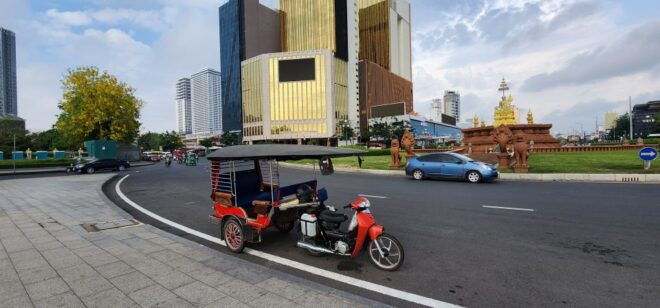
A must-see attraction in Phnom Penh, the Royal Palace offers a glimpse into the opulent grandeur of Cambodia’s monarchy. Steeped in history, the Royal Palace stands as a symbol of Cambodia’s rich cultural heritage.
Built in the 19th century, it has served as the residence of the Kings of Cambodia, making it a significant landmark in the city. The Royal Palace showcases a blend of traditional Khmer architecture with influences from other Southeast Asian styles. The intricate details and ornate designs of the buildings are truly awe-inspiring.
Visitors can explore the various structures within the palace grounds, including the Throne Hall, the Silver Pagoda, and the Khemarin Palace. Each building tells a story and offers a unique insight into the country’s past.
The Royal Palace isn’t just a tourist attraction; it’s a living testament to Cambodia’s royal history and architectural mastery.
More Great Tours NearbyCambodian Vietnam Friendship Monument
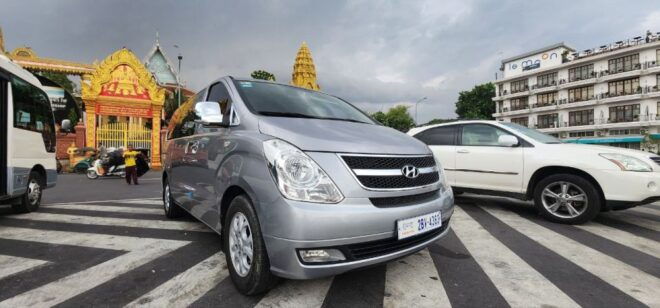
The Cambodian Vietnam Friendship Monument symbolizes the enduring bond between the two nations, showcasing their shared history and cooperation. This monument holds great historical significance, representing the strong alliance between Cambodia and Vietnam.
To paint a picture of this monument, here is a table that highlights its key features:
| Feature | Description |
|---|---|
| Location | Phnom Penh, Cambodia |
| Design | A towering monument depicting two figures holding hands, representing unity and friendship |
| Construction | Built in 1970 as a symbol of solidarity between the two nations |
| Symbolism | Signifies the close relationship and mutual support between Cambodia and Vietnam |
| Historical Significance | Commemorates the joint struggle against foreign aggression and the Cambodian Vietnam alliance |
The Cambodian Vietnam Friendship Monument stands as a testament to the shared history and camaraderie between these two nations. It serves as a reminder of the sacrifices made and the enduring friendship forged in the face of adversity. Visitors to Phnom Penh should not miss the opportunity to visit this important landmark and learn more about the historical significance of the Cambodian Vietnam Friendship Monument.
King Norodom Sihanouk Statue
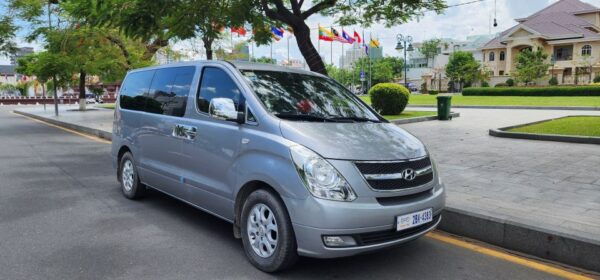
The King Norodom Sihanouk Statue stands tall in a large park strip, honoring the influential leader of Cambodia. With its historical significance and cultural impact, the statue serves as a reminder of King Norodom Sihanouk’s contributions to the country.
As one of Cambodia’s most revered leaders, King Norodom Sihanouk played a crucial role in the nation’s history. He led the country through periods of colonization, independence, and political upheaval. The statue symbolizes his leadership and legacy, depicting him in a regal pose that exudes strength and determination.
It serves as a focal point for both locals and travelers, attracting visitors who wish to pay their respects and learn more about Cambodia’s rich history. The King Norodom Sihanouk Statue stands as a testament to the lasting impact of this remarkable leader.
Independence Monument
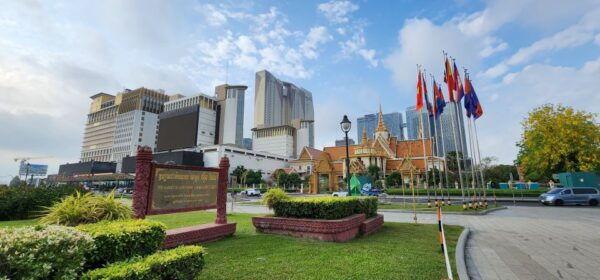
Located in the heart of Phnom Penh, the Independence Monument stands as a symbol of Cambodia’s sovereignty and national pride.
Historical significance of the Independence Monument:
The monument was built in 1958 to commemorate Cambodia’s independence from French colonial rule in 1953. It represents the country’s struggle for freedom and the sacrifices made by its people.
Architectural features of the Independence Monument:
The monument’s design is inspired by Angkor Wat, Cambodia’s most iconic temple. It consists of a lotus-shaped stupa, adorned with intricate carvings and statues. Standing at 37 meters tall, it’s made of white marble and is illuminated at night, creating a stunning sight against the city skyline.
A gathering place for celebrations:
The Independence Monument is a focal point for national celebrations and events, such as Independence Day and the Khmer New Year. It serves as a reminder of Cambodia’s rich history and the resilience of its people.
Symbol of unity:
The monument is a unifying symbol for Cambodians, representing their shared identity and pride in their country. It serves as a reminder of the hardships overcome and the progress achieved since gaining independence.
A must-visit landmark:
Visiting the Independence Monument allows visitors to connect with Cambodia’s history and appreciate its architectural beauty. It’s a testament to the strength and spirit of the Cambodian people.
Genocide Museum
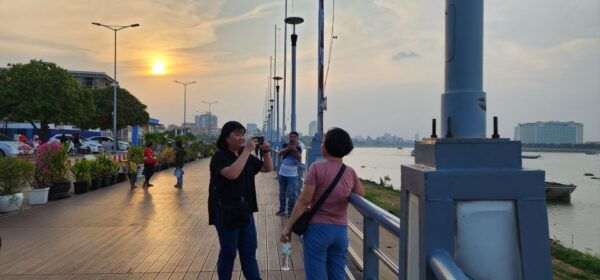
A visit to the Genocide Museum provides a sobering look into Cambodia’s dark history. The museum, also known as the Tuol Sleng Genocide Museum, is located in Phnom Penh and holds great historical significance. It was once a high school, but during the Khmer Rouge regime from 1975 to 1979, it was transformed into a prison known as Security Prison 21 (S-21). Thousands of prisoners were brought here, tortured, and executed. The museum serves as a reminder of the atrocities committed by the Khmer Rouge and the impact it had on Cambodia’s history and society. To evoke emotion in the audience, here is a table that showcases the number of prisoners who entered S-21 and the number who survived:
| Prisoners Entered S-21 | Survivors |
|---|---|
| 20,000 | 7 |
This table highlights the immense loss of life and the brutality of the Khmer Rouge regime. It serves as a stark reminder of the horrors that occurred within the walls of the Genocide Museum.
The Killing Fields
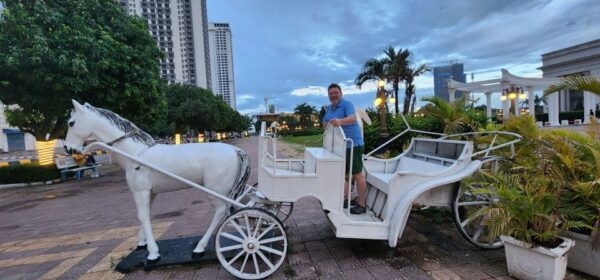
At least 8,895 victims were discovered in the killing fields surrounding Phnom Penh during the Khmer Rouge regime. The historical significance of the Killing Fields and their impact on Cambodia’s history can’t be overstated. Here are some discussion ideas about this haunting site:
The Killing Fields serve as a poignant reminder of the atrocities committed by the Khmer Rouge regime, which claimed the lives of approximately 1.7 million people.
Visiting the Killing Fields allows visitors to pay their respects to the victims and gain a deeper understanding of Cambodia’s dark past.
The site serves as a powerful educational tool, teaching future generations about the horrors that occurred and the importance of preventing such atrocities in the future.
Preserving the Killing Fields is crucial in order to honor the memory of the victims and ensure that their stories aren’t forgotten.
The Genocide Museum, also known as Tuol Sleng, complements the experience at the Killing Fields by providing further insight into the Khmer Rouge regime and its impact on Cambodia.
It’s important to continue educating about these atrocities to prevent history from repeating itself.
The Russian Market
The Russian Market offers visitors the opportunity to explore a vibrant marketplace filled with a wide array of goods and enjoy the bustling atmosphere. This popular shopping destination in Phnom Penh, Cambodia, is known for its unique crafts and offers a truly memorable shopping experience.
The market is a treasure trove of handicrafts, textiles, clothing, jewelry, and souvenirs, making it the perfect place to find that one-of-a-kind item to take home. The Russian Market is also a great place to sample local street food and indulge in traditional Cambodian cuisine.
As you wander through the market, you’ll be captivated by the colorful displays, the friendly vendors, and the lively energy that fills the air. Whether you’re looking to shop or simply soak up the atmosphere, the Russian Market is a must-visit destination in Phnom Penh.
Diamond Island
Why is Diamond Island known as the Paris of Phnom Penh?
Diamond Island, also known as Koh Pich, is a hidden gem in Phnom Penh that offers a modern oasis for visitors to explore. Here are five reasons why Diamond Island is worth discovering:
Modern Architecture: Diamond Island boasts stunning contemporary architectural designs that rival those found in Paris, giving it the nickname ‘Paris of Phnom Penh.’
Riverside Promenade: The island is surrounded by a picturesque riverside promenade, offering breathtaking views of the water and a tranquil atmosphere for a leisurely stroll.
Entertainment Complex: The island is home to a vibrant entertainment complex, featuring shopping malls, restaurants, bars, and a water park, providing endless entertainment options for visitors.
Luxury Living: Diamond Island is a residential area known for its luxurious condominiums and villas, attracting affluent residents who seek a high standard of living in a serene environment.
Recreation Spaces: The island also features well-maintained parks and recreational areas where visitors can relax, exercise, and enjoy outdoor activities.
Exploring Diamond Island is a must for those seeking a modern and vibrant experience in Phnom Penh. Discover the allure of this hidden gem and learn about Phnom Penh’s modern oasis.
Common Questions
What Is the Significance of the Lady Penh Statue at Wat Phnom?
The Lady Penh statue at Wat Phnom holds great significance. It symbolizes the historical importance of Lady Penh, the founder of Phnom Penh. It is a cultural icon and represents local beliefs and reverence for Lady Penh.
What Are the Opening Hours of the National Museum in Phnom Penh?
The National Museum in Phnom Penh is open from 8:00 AM to 5:00 PM. The best time to visit is in the morning to avoid crowds. It showcases traditional Cambodian architecture and offers an insightful look into the country’s rich cultural heritage.
Can I Take Photographs Inside the Royal Palace?
Yes, visitors can take photographs inside the Royal Palace. However, there are rules for photography that must be followed. It is best to check with the staff or guides for specific guidelines.
How Much Time Should I Allocate for Visiting the Genocide Museum?
The recommended duration for visiting the Genocide Museum is around 2-3 hours to fully explore and understand its historical significance. It is best to visit in the morning to avoid crowds and have a more reflective experience.
What Are the Popular Items to Buy at the Russian Market in Phnom Penh?
Popular souvenirs at the Russian Market in Phnom Penh include traditional handicrafts, clothing, jewelry, and artwork. Bargaining is common, so remember to negotiate for the best price. Don’t miss out on these unique finds!
The Sum Up
To sum it up, the ‘Visit 11 Places in the City Included S21 & Killing Field’ tour offers a captivating journey through the vibrant city of Phnom Penh, Cambodia. With its combination of historical landmarks, cultural sites, and opportunities to explore the country’s tragic past, this tour provides a comprehensive experience for visitors.
Led by knowledgeable local guides, you will gain valuable insights into the city’s rich history and cultural heritage. Highly recommended for those seeking a truly immersive exploration of Phnom Penh.
You can check availability for your dates here: More Great Tours NearbyMore City Tours in Phnom Penh
More Tour Reviews in Phnom Penh
Looking for something different? Other Phnom Penh activities we've written about
- 6 Best Shopping Tours In Phnom Penh
- 10 Best Massage And Relaxation Services In Phnom Penh
- 3 Best Motorbike And Scooter Rentals In Phnom Penh
- 25 Best Tours In Phnom Penh
- 2 Best Workshops And Classes In Phnom Penh
- 12 Best 3 Day Tours In Phnom Penh
- 23 Best Boat Tours And Cruises In Phnom Penh
- 6 Best 4 Day Tours In Phnom Penh
- 14 Best Full-Day Tours In Phnom Penh
- 20 Best Private Driver Services In Phnom Penh
- 18 Best Guided Tours In Phnom Penh
- 2 Best 3 Hour Tours and Experiences in Phnom Penh
